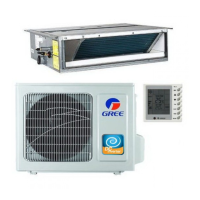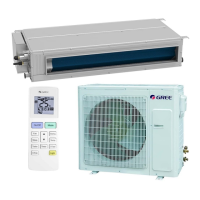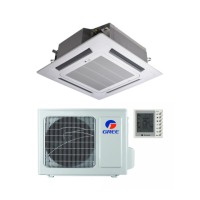GREE U-Match 5 SERIES UNIT SERVICE MANUAL
94
Step 4: Turn on the air conditioner and let it run for a while.
Step 5: Open the low pressure gauge valve (Keep the high pressure gauge valve closed). Then charge in the
remaining charging quantity m`.
Step 6: After all required refrigerant is charged in, close the valve of refrigerant tank.
Step 7: Remove the pressure gauge to finish the refrigerant charging work.
Procedure of refrigerant charging
Following is the supplementary requirement for refrigerant charging on the basis of normal procedure:
1) Make sure that when charging refrigerant into the system, no other types of refrigerant will be mixed.
The pipeline for refrigerant charging should be as short as possible to reduce the amount of refrigerant
left in it.
2) The refrigerant tank should stand erect.
3) Make sure the refrigerating system is already grounded before refrigerant charging.
4) When charging is completed (or not yet completed), stick a label on the system.
5) Before re-charging refrigerant into the system, use oxygen-free nitrogen to perform pressure test. When
charging is completed, perform leak test before trial running. Before leaving the workplace, perform a
leak test again.
4.4 Maintenance of Major Components
4.4.1 Replacement of wired controller
Please refer to the instruction manual of wired controller XE71-42/G or XK117.
4.4.2 How to replace the compressor
4.4.2.1 Diagnosis of compressor failure
A. On condition that the unit can be started up
Step 1:
If the unit can be started up, then start it up to check the current of the faulted compressor. Use a pressure
gauge to measure the pressure of the big and small valves. Connect with a computer to monitor the data. Refer
to the following table based on the recommended working current. The electric current of an inverter compressor
will be different under different rotation speed or different working conditions. If the compressor is working at
60Hz, the working current corresponding to different condensing temperature and evaporating temperature is
shown below:

